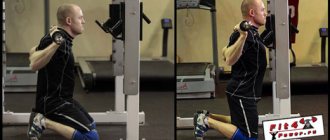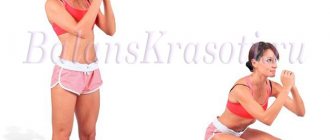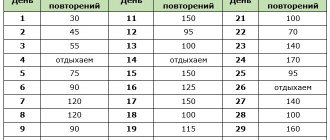Why exclude squats altogether?
For many reasons, for example, injuries to the back muscles, spine, injured knee joints, chronic hemorrhoids, etc. In general, to be honest, squats are not the most beneficial exercise for joints (but one of the most effective), especially when working with heavy weights, which can “erase” the cartilaginous surfaces of the joints and lead to pain and inflammation.
I also know those guys who have big butts, and when they squat, it increases even more (even despite the correct technique required), so they said goodbye to the squat)), I also know those who are afraid for their narrow waist, which when working with heavy weights it will inevitably increase.
Okay, that’s not really the point of the topic. They excluded it, which means there is a reason for it. Because it’s unlikely that anyone will simply exclude one of the most effective exercises out of the blue))).
What are the alternatives, what to do, what exercise to do, how to pump your legs?!
Hack machine squats
This, in fact, although it is a squat (and does not count for our topic), can still be used by those people who do not have problems with their knees, but have problems with the spine or back muscles (and accordingly, they excluded the classic squat because of for this).
Because here the body is fixed, the load on the spine is minimal, but the only negative is that the exercise is traumatic for the knees, especially when working with heavy weights or using the wrong technique... If you decide to try, then my recommendation to you is to be careful, work according to how you feel and don’t rush to progress load on the scales. The quieter you go, the further you'll get. Have you heard?! Here, this saying comes in handy)).
I talked about this exercise in great detail in the main article: “Squats in a hack machine.”
Who are contraindicated for squats?
Squats with a barbell on the shoulders are a basic exercise that involves a huge number of muscles - the quadriceps, hamstrings, buttocks, as well as the core and back muscles. Along with the deadlift, the squat is the main exercise for increasing overall strength and body mass. However, the heavy weights on the barbell, without which the squat will not be as effective, also make it one of the most dangerous movements.
When performing a squat, a large load falls on the back, since at the lowest point the pelvis goes back and the body leans forward. Because of this, the heavy squat is not recommended for people with weak backs or spinal problems such as scoliosis or sciatica.
Another vulnerable part of the body is the knee joints. Any discomfort in the joints during the exercise is a reason to refuse it, since the knees are very easy to injure. In addition, contraindications to squats are hernias, varicose veins in the legs, hypertension and any problems with the cardiovascular system.
Leg press
This exercise is number 2. after squats (at least in my opinion). The exercise is basic, very powerful and effective. The emphasis works on the leg muscles (quadriceps and even hamstrings), the technique is very simple, there is no load on the spine (since you lie with your back pressed against the back of the machine), in general, these are all huge advantages (unlike the same squat, in which the technique is complex, it is also difficult to feel the legs, the load on the spine, etc.).
In fact, if you can’t do any squats, this is the only exercise left in your arsenal, and it’s the one that will build you powerful leg muscles. Read about the technique in the main article, the only thing I want to mention is the AMPLITUDE OF MOTION. If you have ever had knee injuries, do not work at full AMPLITUDE (lowering it all the way down there), up to 90 degrees, maybe even 100, lower is not necessary - otherwise the knees will make themselves felt (judging by myself) + do not straighten at the top point legs to the end (do not straighten your knees, otherwise the load on the muscles will go away from your knees and they will wear out).
Ps leg press (in my opinion) is better than hack machine squats.
I talked about this exercise in great detail in the main article: “Leg Press.”
Iron Health
It is common to think that squats with a barbell are the basis for beautiful and pumped up legs. However, it is not always possible to fulfill them, and there are many reasons for this. Firstly, many of us work in sedentary jobs, spending 5-6 hours in a chair, which negatively affects the lower back. Secondly, they usually go to the gym after work, when they are already pretty exhausted, mental effort and attitude are simply not enough to “beat off” all the planned sets and repetitions, and even with a good working weight.
As a result, many amateurs have the same problem - small and weak legs. But how can you build up your legs without squats? In fact, this is quite possible. We will perform other exercises similar to squats, which put less strain on the lower back and pump up the leg muscles no worse than basic exercises. In just a couple of months, your legs will gain 5-6 cm in volume! Guaranteed!
(1) Leg press
Our goal : quadriceps, hamstrings, buttocks.
How much to do? 4 sets of 8, 4, 10, 10 reps.
Methodology : after a short warm-up, perform 1 set of 8 repetitions. Then hang a 25 kg pancake on each side and perform the next approach, but for 4 repetitions. Next, remove these pancakes and do the last 2 sets 10 times. If you're working out with a partner, do a couple of forced reps on your last set.
Starting position : Lie down on the machine bench. Press your lower back completely into the seat. Grasp the supports with your hands, fix the position of your feet shoulder-width apart and exactly in the middle of the platform.
Execution : Slowly bend your knees at a right angle. Without pausing, powerfully press the platform up with your feet. At the highest point, do not straighten your legs completely. The press is carried out exclusively with the heels, and not with the toes.
Notes:
- If you place your legs wide and high, then most of the load will be on the hamstrings and buttocks. To get proper pumping of the quadriceps, place your legs in the classic position, in which your feet are exactly in the middle of the support.
- Achieve maximum amplitude of the exercise, but lifting your lower back off the bench is not allowed.
(2) Smith Front Squats
Our target : quadriceps, hamstrings and glutes.
How much to do? 3 sets of 10, 10, 12 reps.
Methodology : squats with a barbell on the front load the quadriceps very well, and performing the exercise in the simulator will allow you under no circumstances to lose balance and fully work out the target muscle group.
Starting position : Secure the barbell at mid-chest level. Sit under her and place her top of her chest, close to her collarbone and deltoids. Cross your arms. Ask your partner to remove the bar supports and stand up straight with the barbell.
Execution : Slowly begin the squat until your thighs are parallel to the floor. Eliminate any jerking from the movements; at the highest point of the exercise, do not straighten your knees completely; in all phases, your legs should be slightly bent.
Notes:
- Keep your back straight, especially at the lowest point of the exercise.
- Direct your gaze forward. Don't lift your head up or down. Violation of this rule will lead to overstrain of the cervical spine.
(3) Leg extensions
Our goal : quadriceps.
How much to do? 3-4 sets of 12 times.
Methodology : After completing the main set, reduce the working weight by 25% and do more repetitions until failure. In the last set, reduce the load 3 times in a row.
Starting position : sit on the seat and grab the supports with your hands. Secure your legs to the support rollers, the bend angle of your knees should be 90 degrees.
Execution : Straighten your legs with a powerful, accentuated effort, at the top point make a distinct pause for 1-2 seconds. After this, slowly lower yourself to the starting position. Do not allow the weight to touch the support of the blocks; keep the weight suspended during all phases of the exercise.
Notes:
- At the highest point, be sure to hold for a couple of seconds. The weight is lowered as slowly as possible.
- When lifting weights, do not lift your lower back from the back of the seat and do not tilt your head.
(4) Lunges in Smith
Our goal : quadriceps, hamstrings, buttocks.
How much to do? 3-4 sets of 12 repetitions.
Methodology : this exercise is very effective for the legs precisely because of the simulator, since there is no unnecessary waste of energy to keep the body in balance.
Starting position : Take a position in which the barbell is on your shoulders, as if doing squats. Take a small step forward with one foot and place both feet together. The gaze is directed ahead.
Execution : Take a step back and slowly lower yourself into a squat until the knee of your working leg is bent at a right angle. Next, transfer your weight to your working leg and slowly begin to rise from a squat position. Do the same action with the other leg.
Notes:
- In the lower phase of the exercise, do not let your knee touch the floor.
- Before performing the exercise, your feet should be placed slightly forward. If you place them exactly under the bar, then when performing the exercise you will have to tilt your body forward, which can lead to injury.
(5) Smith Deadlift
Our goal : hamstrings, buttocks.
How much to do? 4 sets of 6, 8, 8, 12 times.
Methodology : This exercise is much easier than the traditional deadlift because it does not require additional effort to maintain balance. Therefore, the working weight here will be noticeably greater.
Starting position : If the fixed rod is too high, use additional support. Grab the bar at shoulder level with your hands and lift the barbell off the supports. Bend your knees slightly, place your feet shoulder-width apart. Direct your gaze straight ahead. Keep your back straight.
Execution : Slowly bend down until your body is parallel to the floor. Try to keep the barbell as close to your feet as possible. The pelvis is pushed back. As soon as the barbell is level with the middle of your shins, stop for a second and return your body to the starting position.
Notes:
- Before starting the movement, try to powerfully contract your buttocks and hamstrings.
- If the lower stops of the machine are too high and do not allow you to lower the barbell to the middle of your shins, use additional support in the form of a pedestal.
(6) Lying leg curls
Our goal : hamstrings.
How much to do? 3 sets of 10 times.
Methodology : This exercise pumps up the hamstrings. To enhance this effect, practice partial repetitions at the end of each set.
Starting position : take a lying position on a bench, place your legs on special support rollers. With your hands, firmly grasp the stops that are located on the sides of the machine. Keep your head straight.
Execution : With concentrated effort, slowly lift the rollers to their maximum height, as close to the buttocks as possible. At the top point, be sure to pause for 1-2 seconds and only after that slowly lower the weight. After failure reps, try doing as many partial reps as you can.
Notes:
- When performing the exercise, completely exclude the pelvis from the work. Try not to tear him away from the bench.
- Keep your feet exclusively in a flat position. Do not bring your socks together and do not allow them to “slide” to the sides.
Now let's combine these six exercises into a sample training program aimed at pumping up the leg muscles.
| Training exercises | Number of approaches | Number of repetitions |
| Leg press | 4 | 8, 4, 10, 10 |
| Front squats in Smith | 3 | 10, 10, 12 |
| Leg extensions | 3 | 12, 12, 12 |
| Lunges in Smith | 3 | 12, 12, 12 |
| Deadlift in Smith | 4 | 6, 8, 8, 12 |
| Leg Curls | 4 | 8, 4, 10, 10 |
Half lunges with a barbell (more basic) than with dumbbells
Half lunges and regular lunges (difference)
Please note, not ordinary lunges, but half-lunges - this is when the step is not wide. Thanks to this, the emphasis is placed on the quadriceps, and some of the load is removed from the butt. Although, in fact, in any lunge the load is directed to the butt, quadriceps, hip adductors and hip flexors. But, if you wish, you can focus (to the maximum) on the quadriceps, focusing on the butt (if there is such a goal) or vice versa. To do this, you need all the nuances, read about them in the main article: “Lunges.”
Deadlift with barbell/dumbbells
This exercise is aimed at developing the so-called. biceps of the thigh (back of the thigh), because who doesn’t know, there is a front (quadriceps) and a back (hamstrings), so in order for your legs to look proportional (large, muscular, beautiful), you need to develop both. You can’t go far with just quadriceps)), but many people neglect their biceps. hips









